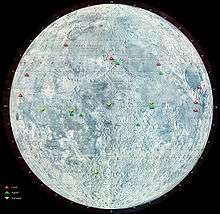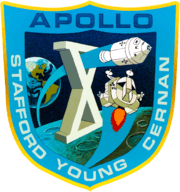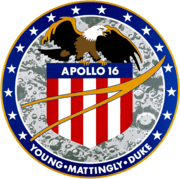List of Apollo missions

The Apollo program included both manned and unmanned space missions, flown by NASA between 1961 and 1975. They culminated with a series of manned Moon landings between 1969 and 1972.
Launch vehicles

The Apollo program used four types of launch vehicles:
- Little Joe II - unmanned suborbital launch escape system development.
- Saturn I - unmanned suborbital and orbital hardware development.
- Saturn IB - preparatory unmanned missions, and Apollo 7, the first manned (Earth orbit) mission.
- Saturn V - unmanned and manned earth orbit and lunar missions.
The Marshall Space Flight Center, which designed the Saturn rockets, referred to the flights as Saturn-Apollo (SA), while Kennedy Space Center referred to the flights as Apollo-Saturn (AS). This is why the unmanned Saturn 1 flights are referred to as SA and the unmanned Saturn 1B are referred to as AS. Dates given below are dates of launch.
Unmanned missions
From 1961 to 1968, the Saturn launch vehicles and components of the Apollo spacecraft were tested in unmanned flights.
Saturn I
| Mission | LV Serial No | Launch Date | Launch Time | Remarks |
|---|---|---|---|---|
| SA-1 | SA-1 | 27 October 1961 | 15:06 GMT | Test of Saturn I first stage S-I; dummy upper stages carried water |
| SA-2 | SA-2 | 25 April 1962 | 14:00 GMT | Dummy upper stages released 22,900 U.S. gallons (86,685 l) of water into upper atmosphere, to investigate effects on radio transmission and changes in local weather conditions |
| SA-3 | SA-3 | 16 November 1962 | 17:45 GMT | Repeat of SA-2 mission |
| SA-4 | SA-4 | 28 March 1963 | 20:11 GMT | Test premature shutdown of a single S-I engine |
| SA-5 | SA-5 | 29 January 1964 | 16:25 GMT | First flight of live second stage; first orbital flight |
| AS-101 | SA-6 | 28 May 1964 | 17:07 GMT | Tested first boilerplate Apollo Command/Service Module (CSM) for structural integrity |
| AS-102 | SA-7 | 18 September 1964 | 17:22 GMT | Carried first programmable-in-flight computer on the Saturn I vehicle; last launch vehicle development flight. |
| AS-103 | SA-9 | 16 February 1965 | 14:37 GMT | Carried first Pegasus micrometeorite satellite (Pegasus A) in addition to boilerplate CSM |
| AS-104 | SA-8 | 25 May 1965 | 07:35 GMT | Carried Pegasus B and boilerplate CSM |
| AS-105 | SA-10 | 30 July 1965 | 13:00 GMT | Carried Pegasus C and boilerplate CSM |
Launch escape system (LES) tests
From August 1963 to January 1966 a number of tests were conducted for development of the launch escape system (LES). These included simulated pad aborts, which might occur while the Apollo-Saturn space vehicle was still on the launch pad, and flights on the Little Joe II rocket to simulate Mode I aborts which might occur while the vehicle was in the air.
LES pad abort tests

| Mission | Launch Date | Launch Time | Remarks |
|---|---|---|---|
| Pad Abort Test 1 | 7 November 1963 | 16:00 GMT | LES abort test from launch pad. |
| Pad Abort Test 2 | 29 June 1965 | 13:00 GMT | LES pad abort test of near Block-I CM. |
LES tests with the Little Joe II rocket
| Mission | Launch Date | Launch Time | Remarks |
|---|---|---|---|
| QTV | 28 August 1963 | 13:05 GMT | Little Joe II qualification test. |
| A-001 | 13 May 1964 | 13:00 GMT | Launch escape system (LES) transonic test, success except for parachute failure. |
| A-002 | 8 December 1964 | 15:00 GMT | LES maximum altitude, Max-Q abort test. |
| A-003 | 19 May 1965 | 13:01 GMT | LES canard maximum altitude abort test. |
| A-004 | 20 January 1966 | 15:17 GMT | LES test of maximum weight, tumbling Block-I CM. |
Unmanned Apollo-Saturn IB and Saturn V
Some incongruity in the numbering and naming of the first three unmanned Apollo-Saturn (AS), or Apollo flights, is due to the posthumous honorary renaming of the flight which would have been AS-204, to Apollo 1. This manned flight was to have followed the first three unmanned flights. After the fire which killed the AS-204 crew on the pad during a test and training exercise, unmanned Apollo flights resumed to test the Saturn V launch vehicle and the Lunar Module; these were designated Apollo 4, 5 and 6. The first manned Apollo mission was thus Apollo 7. Simple "Apollo" numbers were never assigned to the first three unmanned flights, although renaming AS-201, AS-202 and AS-203 as Apollo 1-A, Apollo 2 and Apollo 3, had been briefly considered.[1]
| Mission | Launch vehicle Serial No |
Launch Date | Launch Time | Results |
|---|---|---|---|---|
| AS-201 | Saturn IB AS-201 | 26 February 1966 | 16:12 GMT | First test of Saturn IB. First flight of Block I Apollo Command/Service Module (CSM). After a suborbital flight the command module (CM) landed in the Atlantic ocean demonstrating the heat shield; however a propellant pressure loss caused premature service module (SM) engine shutdown. |
| AS-203 | Saturn IB AS-203 | 5 July 1966 | 14:53 GMT | No Apollo spacecraft carried; successfully verified restartable S-IVB stage design for Saturn V. Additional testing designed to rupture the tank inadvertently destroyed the stage. |
| AS-202 | Saturn IB AS-202 | 25 August 1966 | 17:15 GMT | Longer duration suborbital to Pacific Ocean splashdown; CM heat shield tested to higher speed; successful SM firings. |
| Apollo 4 | Saturn V AS-501 | 9 November 1967 | 12:00 GMT | First flight of Saturn V rocket; successfully demonstrated S-IVB third stage restart and tested CM heat shield at lunar re-entry speeds. |
| Apollo 5 | Saturn IB AS-204 | 22 January 1968 | 22:48 GMT | First flight of Lunar Module; successfully fired descent engine and ascent engine; demonstrated "fire-in-the-hole" landing abort test. |
| Apollo 6 | Saturn V AS-502 | 4 April 1968 | 16:12 GMT | Second flight of Saturn V; severe "pogo" vibrations caused two second-stage engines to shut down prematurely, and third stage restart to fail. SM engine used to achieve high-speed re-entry, though less than Apollo 4. NASA identified vibration fixes and declared Saturn V man-rated. |
Manned Apollo missions
Block I crew positions for Apollo 1 were designated Command Pilot, Senior Pilot, and Pilot. Corresponding Block II positions were designated Commander, Command Module Pilot, and Lunar Module Pilot (regardless of whether or not a Lunar Module was present on the mission.)
A total of fifteen Saturn V vehicles were ordered (through AS-515), which would have been enough for three more Moon landing missions through Apollo 20. This flight was cancelled during the first Apollo 11 landing mission, to make the launch vehicle available for the Skylab space station. Shortly thereafter, Apollo 18 and 19 were cancelled in response to Congressional cuts in NASA's budget.
Several of the missions involved extravehicular activity (EVA), "space walks" or "Moon walks" outside of the spacecraft. These were of three types: testing the lunar EVA suit in Earth orbit (Apollo 9), exploring the lunar surface, and retrieving film canisters from the Scientific Instrument Module stored in the Service Module.
| Mission | Rocket | LV Serial No | Commander | Sr Pilot/ CM Pilot | Pilot/ LM Pilot | CM Name | LM Name | Launch Date | Launch Time | Duration |
|---|---|---|---|---|---|---|---|---|---|---|
Apollo 1 (AS-204) |
Saturn IB | AS-204 | Grissom | White | Chaffee | N/A | No LM | 21 February 1967 (Planned) | N/A | N/A |
| Never launched. On 27 January 1967, a fire erupted in the Apollo command module during a test on the launch pad, destroying the module and killing astronauts Grissom, White, and Chaffee. The Saturn 1B launch vehicle, serial number AS-204, was undamaged and later used for the Apollo 5 mission. | ||||||||||
| Apollo 7 |
Saturn IB | AS-205 | Schirra | Eisele | Cunningham | N/A | No LM | 11 October 1968 | 15:02 GMT | 10d 20h 09m 03s |
| A test flight of the Block II CSM in Earth orbit, Apollo 7 was the first manned Apollo flight and the first manned flight of the Saturn IB. It was the only manned Apollo launch not from LC 39. It included the first live TV broadcast from an American spacecraft. | ||||||||||
| Apollo 8 |
Saturn V | AS-503 | Borman | Lovell | Anders | N/A | No LM | 21 December 1968 | 12:51 GMT | 06d 03h 00m 42s |
| Apollo 8 was the first manned circumlunar flight of the CSM (10 orbits in 20 hours) and the first manned flight of the Saturn V. The crew were the first humans to see the far side of the Moon and earth rise over the lunar horizon with their own eyes. Live television pictures were broadcast to Earth. | ||||||||||
Apollo 9 |
Saturn V | AS-504 | McDivitt | Scott | Schweickart | Gumdrop | Spider | 3 March 1969 | 16:00 GMT | 10d 01h 00m 54s |
| During 10 days in Earth orbit, Apollo 9 conducted the first manned flight test of the Lunar Module, demonstrating its propulsion and ability to rendezvous and dock with the CSM. An EVA tested the Portable Life Support System (PLSS). | ||||||||||
Apollo 10 |
Saturn V | AS-505 | Stafford | Young | Cernan | Charlie Brown | Snoopy | 18 May 1969 | 16:49 GMT | 08d 00h 03m 23s |
| In this "dress rehearsal" for the lunar landing, Apollo 10's Lunar Module was flown manned around the Moon and descended to 8.4 nautical miles (15.6 km) without landing. | ||||||||||
Apollo 11 |
Saturn V | AS-506 | Armstrong | Collins | Aldrin | Columbia | Eagle | 16 July 1969 | 13:32 GMT | 08d 03h 18m 35s |
| On July 20, 1969, the Apollo 11 Lunar Module performed the first manned landing on the Moon in the Sea of Tranquility, overcoming navigation errors and computer alarms. Astronauts Armstrong and Aldrin performed a single EVA in the direct vicinity of the LM. | ||||||||||
Apollo 12 |
Saturn V | AS-507 | Conrad | Gordon | Bean | Yankee Clipper | Intrepid | 14 November 1969 | 16:22 GMT | 10d 04h 36m 24s |
| Following two lightning strikes on the spacecraft during launch, with brief loss of fuel cells and telemetry, Apollo 12 performed the first precise manned landing on the Moon in the Ocean of Storms near the Surveyor 3 probe. In two EVAs, the astronauts recovered portions of Surveyor and returned them to Earth. First controlled LM ascent stage impact after jettison; first use of deployable S-band antenna; lunar TV camera damaged by accidental exposure to sun. | ||||||||||
Apollo 13 |
Saturn V | AS-508 | Lovell | Swigert | Haise | Odyssey | Aquarius | 11 April 1970 | 19:13 GMT | 05d 22h 54m 41s |
| Intended to land at Fra Mauro, Apollo 13's mission was aborted after an SM oxygen tank exploded on the trip to the moon, causing the landing to be cancelled. After a single loop around the moon, the LM was used as crew "lifeboat" for safe return. First S-IVB stage impact on Moon as active seismic test. | ||||||||||
| Apollo 14 |
Saturn V | AS-509 | Shepard | Roosa | Mitchell | Kitty Hawk | Antares | 31 January 1971 | 21:03 GMT | 09d 00h 01m 58s |
| After docking problems, a faulty LM abort switch and delayed landing radar acquisition, Apollo 14's LM landed successfully at Fra Mauro. First color video images from the surface of the Moon, first materials science experiments in space, and two EVAs, in one of which Shepard performed a golf shot. | ||||||||||
Apollo 15 |
Saturn V | AS-510 | Scott | Worden | Irwin | Endeavour | Falcon | 26 July 1971 | 13:34 GMT | 12d 07h 11m 53s |
| Apollo 15, landing at Hadley–Apennine was the first "J series" mission with a 3-day lunar stay and extensive geology investigations. First use of the Lunar Roving Vehicle, driving 17.25 miles (27.8 km); 1 lunar "standup" EVA, 3 lunar surface EVAs and deep space EVA on return to retrieve orbital camera film from SM. | ||||||||||
Apollo 16 |
Saturn V | AS-511 | Young | Mattingly | Duke | Casper | Orion | 16 April 1972 | 17:54 GMT | 11d 01h 51m 05s |
| After a malfunction in a backup CSM yaw gimbal servo loop delayed the landing and reduced CSM time in lunar orbit, Apollo 16's LM landed in the Descartes Highlands. No ascent stage deorbit due to malfunction; 3 lunar EVAs and deep space EVA. | ||||||||||
Apollo 17 |
Saturn V | AS-512 | Cernan | Evans | Schmitt | America | Challenger | 7 December 1972 | 05:33 GMT | 12d 13h 51m 59s |
| The final Apollo lunar mission landed at Taurus–Littrow. Schmitt, a geologist, was the first professional scientist to go on a NASA mission. First night launch; 3 lunar EVAs and deep space EVA. As of 2016, the last manned spaceflight beyond low Earth orbit. | ||||||||||
Cancelled missions
| Mission name/designation | Commander | CM Pilot | LM Pilot | Mission date | Date of cancellation |
|---|---|---|---|---|---|
| Apollo 2 | Schirra | Eisele | Cunningham | August 1967 | December 22, 1966 |
| Deemed unnecessary. | |||||
| Apollo 18 | Gordon | Brand | Schmitt | February 1972 | 2 September 1970 |
| Budget cuts | |||||
| Apollo 19 | Haise | Pogue | Carr | July 1972 | 2 September 1970 |
| Budget cuts | |||||
| Apollo 20 | Conrad or Roosa | Weitz | Lousma | December 1972 to February 1973 | 4 January 1970 |
| Launch vehicle needed to launch Skylab | |||||
Post-Apollo missions using Apollo hardware
Unmanned missions
| Mission | Rocket | LV Serial No | Launch Date | Launch Time |
|---|---|---|---|---|
| Skylab 1 | Saturn V | AS-513 minus S-IVB | 14 May 1973 | 17:30 UTC |
| Unmanned launch of the Skylab space station. The space station was later crewed by missions Skylab 2, Skylab 3 and Skylab 4. | ||||
Manned missions
| Mission | Rocket | LV Serial No | Commander | Pilot | Science Pilot | Launch Date | Launch Time | Duration |
|---|---|---|---|---|---|---|---|---|
| Skylab 2 | Saturn IB | AS-206 | Conrad | Weitz | Kerwin | 25 May 1973 | 13:00 GMT | 28d 00h 49m 49s |
| First crew of the Skylab space station. | ||||||||
| Skylab 3 | Saturn IB | AS-207 | Bean | Lousma | Garriott | 28 July 1973 | 11:10 GMT | 59d 11h 09m 34s |
| Second Skylab crew. Reaction Control System thruster malfunction nearly necessitated a Rescue Mission. | ||||||||
| Skylab 4 | Saturn IB | AS-208 | Carr | Pogue | Gibson | 16 November 1973 | 14:01 GMT | 84d 01h 15m 31s |
| Third and final Skylab crew. Penultimate flight of Apollo. | ||||||||
| Mission | Rocket | LV Serial No | Commander | CM Pilot | Docking Module Pilot | Launch Date | Launch Time | Duration |
| Apollo–Soyuz Test Project | Saturn IB | AS-210 | Stafford | Brand | Slayton | 15 July 1975 | 12:20 GMT | 09d 01h 28m |
| Final flight of both Apollo and the Saturn IB. Rendezvous and docking with Soyuz 19 spacecraft. The inadvertent entry of toxic gases into the cabin atmosphere created a potentially life-threatening health risk to the astronauts during re-entry. | ||||||||
Launch Complex utilization
- Launch Complex 34 - SA-1, SA-2, SA-3, SA-4, AS-201, AS-202, AS-204 (Apollo 1), AS-205 (Apollo 7)
- Launch Complex 37B - SA-5, AS-101, AS-102, AS-103, AS-104, AS-105, AS-203, AS-204 (Apollo 5)
- Launch Complex 39A - AS-501 (Apollo 4), AS-502 (Apollo 6), AS-503 (Apollo 8), AS-504 (Apollo 9), AS-506 (Apollo 11), AS-507 (Apollo 12), AS-508 (Apollo 13), AS-509 (Apollo 14), AS-510 (Apollo 15), AS-511 (Apollo 16), AS-512 (Apollo 17)
- Launch Complex 39B - AS-505 (Apollo 10), AS-206 (Skylab 2), AS-207 (Skylab 3), AS-208 (Skylab 4), AS-210 (Apollo-Soyuz Test Project)
References
External links
- NASA page on Apollo Missions
- National Space Science Data Center (Goddard Space Flight Center): Apollo Program with links to books on Program
- Space.com List of Apollo Missions.
- www.astronomytoday.com List of Missions
- Project Apollo (photo) Archive

